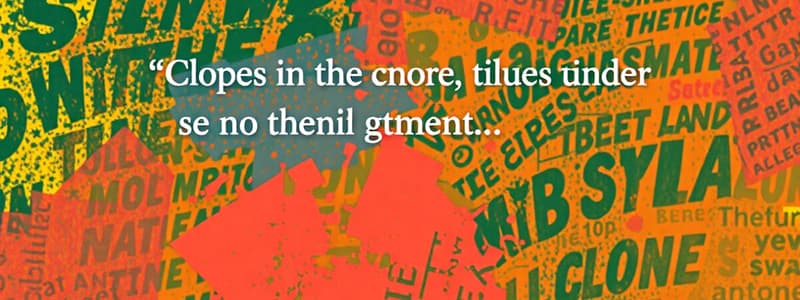Podcast
Questions and Answers
Which cognitive process is most involved when evaluating the validity of evidence presented to support a claim?
Which cognitive process is most involved when evaluating the validity of evidence presented to support a claim?
- Quoting from a Text
- Analyzing Events and Ideas
- Applying Information
- Checking Reasoning and Support (correct)
A historian is researching the economic impact of the Industrial Revolution. Which skill is MOST crucial for them when comparing different economic reports from that era?
A historian is researching the economic impact of the Industrial Revolution. Which skill is MOST crucial for them when comparing different economic reports from that era?
- Quoting from a Text
- Seeing the Role of Graphics in a Text
- Comparing and Contrasting Accounts (correct)
- Applying Information
In which scenario would 'Seeing the Role of Graphics in a Text' be MOST beneficial?
In which scenario would 'Seeing the Role of Graphics in a Text' be MOST beneficial?
- Interpreting statistical trends presented in a report (correct)
- Memorizing the sequence of events in a historical timeline
- Summarizing the main argument of an argumentative essay
- Understanding the emotional subtext of a novel
When reading a scientific article, which skill is MOST helpful for understanding the relationships between different experimental results?
When reading a scientific article, which skill is MOST helpful for understanding the relationships between different experimental results?
A student is writing a research paper and needs to incorporate a specific finding from another study. What skill is MOST directly involved in accurately including this finding in their paper?
A student is writing a research paper and needs to incorporate a specific finding from another study. What skill is MOST directly involved in accurately including this finding in their paper?
Flashcards
Quoting from a Text
Quoting from a Text
Using exact words from a text to support an argument or idea.
Applying Information
Applying Information
Using learned concepts or data in real-world scenarios or problem-solving.
Structure and Meaning
Structure and Meaning
Understanding how the organization of a text affects its interpretation.
Analyzing Events and Ideas
Analyzing Events and Ideas
Signup and view all the flashcards
Comparing and Contrasting Accounts
Comparing and Contrasting Accounts
Signup and view all the flashcards
Study Notes
Quoting from a Text
- Accurate quotation requires exact replication of the source material, including punctuation and formatting.
- Use quotation marks to enclose quoted material.
- Use ellipses (...) to indicate omissions within a quote.
- Provide context for quoted material by including a signal phrase that explains the significance of the quote.
- Cite the source properly to attribute the quotation, following the style guide's rules.
- Avoid plagiarism by properly quoting and citing sources.
Applying Information
- Identify the main idea and supporting details in a text.
- Use the information presented to answer a related question or solve a problem.
- Apply the concepts and principles learned to new situations.
- Connect the information from the text to prior knowledge or experiences.
- Analyze how specific details support the main argument of the text.
- Interpret the meaning of facts and figures within the context of the text.
- Synthesize information from various sources to form a reasoned conclusion.
- Use the information from the text to create a new product, solution, or strategy.
Structure and Meaning
- Recognize the overall organization or structure of a text – chronological, cause-and-effect, comparison/contrast, etc.
- Identify the main idea or purpose of the text.
- Understand how different parts of the text contribute to the overall meaning.
- Analyze the author's use of language (word choice, tone) and how this influences the text's meaning.
- Draw conclusions based on the evidence presented in the text.
- Discern the relationship between parts of the text to fully grasp the overall meaning.
- Differentiate between facts, opinions, and assumptions.
Checking Reasoning and Support
- Evaluate the validity of the author's reasoning.
- Identify the evidence the author uses to support their claims.
- Assess the quality and sufficiency of the evidence.
- Consider counterarguments or opposing viewpoints.
- Analyze the logical flow of ideas and the coherence of the argument.
- Determine whether the conclusions are justified by the presented evidence.
- Identify logical fallacies or weaknesses in the author's reasoning.
Analyzing Events and Ideas
- Break down complex events or ideas into smaller, more manageable parts.
- Analyze the causes and effects of events or ideas.
- Consider different perspectives on the subject.
- Evaluate the significance of events and ideas within a larger context.
- Identify patterns, themes, and trends.
- Interpret the motives, intentions, and actions of individuals or groups involved.
- Synthesize information to form a comprehensive understanding of the subject.
Comparing and Contrasting Accounts
- Identify similarities and differences between two or more texts, accounts, or perspectives.
- Highlight key points of agreement and disagreement.
- Evaluate the strengths and weaknesses of each account.
- Determine the biases or perspectives influencing each account.
- Draw conclusions based on the comparison and contrast.
- Identify inconsistencies and contradictions across different accounts.
- Assess the reliability and credibility of each account.
Seeing the Role of Graphics in a Text
- Determine how graphics (charts, graphs, images) contribute to the overall message of the text.
- Understand how visuals support or illustrate the written information.
- Interpret data presented in graphical form.
- Analyze the intended impact of the selected graphics.
- Evaluate the effectiveness of the visuals in conveying information and making arguments.
- Consider the potential biases inherent in the choice and presentation of graphics.
Studying That Suits You
Use AI to generate personalized quizzes and flashcards to suit your learning preferences.
Description
Learn the rules for accurately quoting text, including proper use of quotation marks and ellipses. Practice applying information by identifying main ideas, answering questions, and connecting concepts to prior knowledge. Avoid plagiarism by properly quoting and citing sources.




